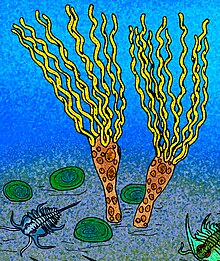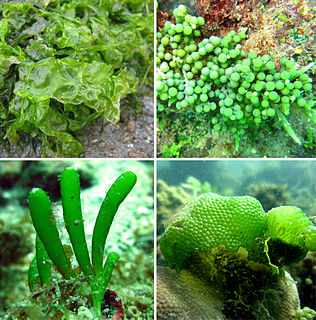
The Ulvophyceae or ulvophytes are a class of green algae, distinguished mainly on the basis of ultrastructural morphology, life cycle and molecular phylogenetic data. The sea lettuce, Ulva, belongs here. Other well-known members include Caulerpa, Codium, Acetabularia, Cladophora, Trentepohlia and Monostroma.

Anseranatidae, the magpie-geese, is a biological family of waterbirds. The only living species, the magpie goose, is a resident breeder in northern Australia and in southern New Guinea.

Ensifera is a suborder of insects that includes the various types of crickets and their allies including: true crickets, camel crickets, bush crickets or katydids, grigs, weta and Cooloola monsters. This and the suborder Caelifera make up the order Orthoptera. Ensifera is believed to be a more ancient group than Caelifera, with its origins in the Carboniferous period, the split having occurred at the end of the Permian period. Unlike the Caelifera, the Ensifera contain numerous members that are partially carnivorous, feeding on other insects, as well as plants.
Zapalasaurus is a genus of sauropod dinosaur described by Leonardo Salgado, Ismar de Souza Carvalho and Alberto Garrido in 2006. It was named after the city of Zapala, which is approximately 80 kilometres (50 mi) away from where the holotype was discovered. The type species, Zapalasaurus bonapartei, was found in the La Amarga Formation of the Neuquén Basin, Neuquén Province, Argentina. It was a diplodocoid, a long-necked herbivore, and it lived during the Early Cretaceous. The authors conclude from examining the skeleton that "The record of Zapalasaurus bonapartei shows that, at least in the Neuquén Basin, basal diplodocoids were more diverse than previously thought." Zapalasaurus is assumed to have a long neck which would have been developed for feeding adaption, allowing its neck to swing in an arc like shape. This would allow Zapalasaurus to browse a wide variety of plants and greens without having to walk very far.

Cryptoclididae is a family of medium-sized plesiosaurs that existed from the Middle Jurassic to the Early Cretaceous. They had long necks, broad and short skulls and densely packed teeth. They fed on small soft-bodied preys such as small fish and crustaceans. The earliest members of the family appeared during the early Bajocian, and they represented the dominant group of long-necked plesiosaurs during the latter half of the Jurassic.
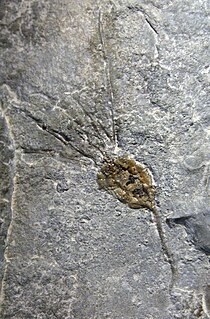
Gogia is a genus of primitive eocrinoid blastozoan from the early to middle Cambrian.
Geobios is an academic journal published bimonthly by the publishing house Elsevier. Geobios is an international journal of paleontology, focusing on the areas of palaeobiology, palaeoecology, palaeobiogeography, stratigraphy and biogeochemistry.

Gulripshi District is a district of Abkhazia, one of Georgia’s breakaway republics. It corresponds to the eponymous Georgian district. Its capital is Gulripshi, the town by the same name. Until the August 2008 Battle of the Kodori Valley, the north-eastern part of Gulripshi district was part of Upper Abkhazia, the corner of Abkhazia controlled by Georgia until the Battle of the Kodori Valley during the August 2008 South Ossetia War. Upper Abkhazia was home to 1,956 of the district's 19,918 inhabitants, most of whom were ethnic Svans. Most of these fled before the battle and have not yet returned.

Créchy is a commune in the Allier department in central France.
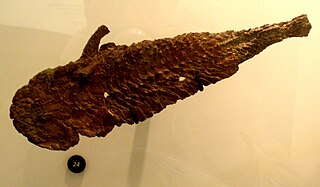
The Megalichthyidae are a family of prehistoric lobe-finned fishes which lived from the late Devonian to the early Permian period.
Tarachomylax is an extinct genus of prehistoric sarcopterygians or lobe-finned fish.
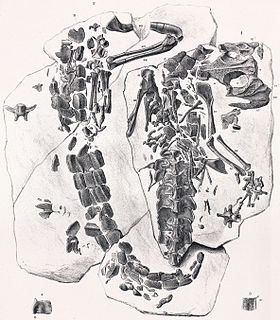
Theriosuchus is an extinct genus of atoposaurid mesoeucrocodylian from Late Jurassic to Early Cretaceous of Europe, Southeast Asia (Thailand) and western North America (Wyoming), with fragmentary records from Middle Jurassic and Early Cretaceous sites in China, Morocco, and Scotland.
Meiconodon is an extinct genus of alticonodontine triconodontid which existed in China during the early Cretaceous period. It was described by Nao Kusuhashi, Yaoming Hu, Yuanqing Wang, Satoshi Hirasawa and Hiroshige Matsuoka in 2009 and the type species is Meiconodon lii.

Akaki Gogia is a professional footballer who plays as a midfielder for FC Zürich. He began his career in Germany with VfL Wolfsburg, before signing for Hallescher FC in 2013 and moving to England to join Brentford in 2015. He returned to Germany with Union Berlin in 2017 and moved to Switzerland to join FC Zürich in 2021. Born in Georgia, Gogia won international youth caps for Germany at U18 and U19 level. His nickname is "Andy".
Schizodelphis is an extinct genus of cetacean.

Cynohyaenodon is an extinct paraphyletic genus of hyaenodontid mammal that lived during the early to middle Eocene in Europe.

Galecyon is a genus of hyaenodont that lived during the early Eocene in Europe and North America.

Sinamiidae is an extinct family of ray-finned fish. They are halecomorph fishes endemic to Early Cretaceous freshwater environments in eastern Asia.
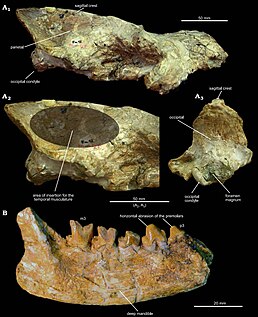
Eurotherium is an extinct paraphyletic genus of hyaenodontid mammal that lived during the early to middle Eocene in Europe.
Tirolites is an extinct genus of ammonites. Its first appearance defines the Smithian-Spathian boundary of the Early Triassic, and it is prominent in the Paris biota.
